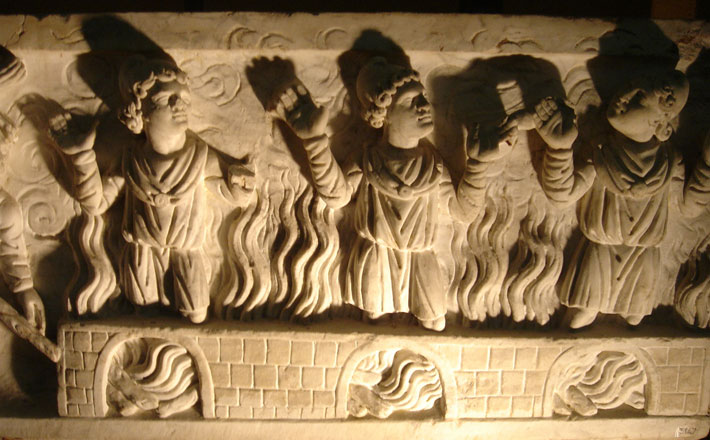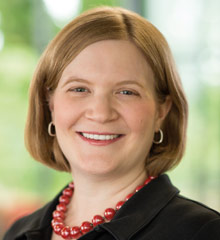Commentary on Exodus 14:10-31; 15:20-21
Have you ever taken your Bible to an unusual or unfamiliar place to read and study?
Old words can sound very different in a new setting. Take, for example, Elijah’s first encounter with the widow of Zarephath and her son (1 Kings 17:8-16), in which the prophet fills the starving family’s food jars with inexhaustible meal and oil. Imagine reading that story in five-star restaurant, in a homeless shelter, and in the rotunda of the U.S. Capitol. The words can resonate very differently according to the context in which they are read.
What changes, then, when we read the story of the Israelites’ exodus from Egypt at the Easter Vigil instead of in a “regular” Sunday morning worship service? How do these old words sound in a new setting? In the Easter vigil, the grief of Good Friday and the doubt of Saturday give way to the hope of Sunday morning. Joy begins to emerge, because we know what is coming. We know how this story ends, or rather, how the story is transformed and begins anew. Life conquers death; resurrection transforms hopelessness; forgiveness and reconciliation triumph over sin and brokenness. At the vigil we live the “already / not yet” of Christian faith perhaps more concretely than at any other time of the year. We celebrate as people already redeemed, even as we once again anticipate the redemption that is to come.
Given this unique context, I can imagine several ways that the exodus narrative will echo differently at the Easter vigil:
- “Moses said to the people, ‘Do not be afraid, stand firm, and see the deliverance that the LORD will accomplish for you today’” (Exodus 14:13a). Moses exhorts the Israelites with three imperatives: do not fear, stand firm, and see. These commands strike me as just what we are called to do at the Easter vigil. We take courage, we stay put (this is a vigil, after all!), and we act as witnesses to the redemption that God is working for us. Just as God delivered the Israelites at the sea, God delivers the world from the powers of sin and death at the cross.
- “So Moses stretched out his hand over the sea, and at dawn the sea returned to its normal depth. As the Egyptians fled before it, the LORD tossed the Egyptians into the sea” (Exodus 14:27). Many readers feel a little squeamish when reading about the demise of the Egyptians at the hands of God. Or what about all those innocent Egyptians who suffered during the ten plagues? Couldn’t God have accomplished this deliverance without all this bloodshed? As admirable as these difficult questions may be, and as heartfelt as the concern for the Egyptians may be, I daresay that any hedging against the appropriateness of God’s total triumph will — and perhaps should — recede at the Easter vigil. In the Exodus narrative Egypt epitomizes the world’s powers of slavery, torture, destruction, and death. The “civilization” that Pharaoh has cultivated is already one of exploitation, of both his own people as well as the Israelites. We remember in the exodus and in the resurrection that God opposes the death-dealing ways of the world, which privilege money and power over justice and love. God’s victory is, ultimately, one of life over death: servitude to God instead of to Pharaoh, a privileging of the powers of heaven over the powers of earth. Thus, when Miriam sings, “Horse and rider he has thrown into the sea!” we also hear the taunt of 1 Corinthians 15:55, “O death, where is your victory?” God has accomplished life.
- “Then the prophet Miriam, Aaron’s sister, took a tambourine in her hand; and all the women went out after her with tambourines and with dancing” (Exodus 15:20). Care is given in both the exodus story and the resurrection narrative to highlight the role of women. Miriam leads the Israelite women in their victory songs. It is likely that women led musical celebrations after any military victory, and their presence in Exodus underscores the war imagery that permeates the exodus event: God has defeated Pharaoh in battle. Miriam is named specifically as a prophet in the text, but the women who discover the empty tomb and deliver the news to the disciples are similarly prophetic. They are serving, according to the classic definition of a prophet, as “mouthpieces of God”; they deliver God’s word to those who need to hear it. The Bible has a reputation as a male-centric text, and it often deserves that reputation. However, in these key narratives, women take central roles.
- “Israel saw the great work that the LORD did against the Egyptians. So the people feared the LORD and believed in the LORD and in his servant Moses” (Exodus 14:31). As Pharaoh’s army is bearing down on them at the edge of the sea, the Israelites are terrified. They yell at God and at Moses, sure they have been brought out of Egypt simply to perish in the wilderness (14:11-12). But when they see, as they have been commanded to do (14:13), they believe. Witnessing this mighty act of deliverance ignites faith in the Israelites. Yet we need only turn a page or two to see how quickly they forget. Just on the other side of the Red Sea, thirsty and faced with bitter water, they complain against Moses (15:24), by no means for the last time. One hardship sets in, and their faith blows away in the wind. How much are we like the Israelites in the wilderness! We may leave the Easter vigil or the Easter morning services with our hearts on fire with faith, nourished for our journeys once again. But it only takes a few moments for the enthusiasm to recede and for “real life” to settle in. Preachers are challenged at Easter not only to help us celebrate the day, but also to help us cultivate a faith that travels with us for a lifetime.


April 4, 2015